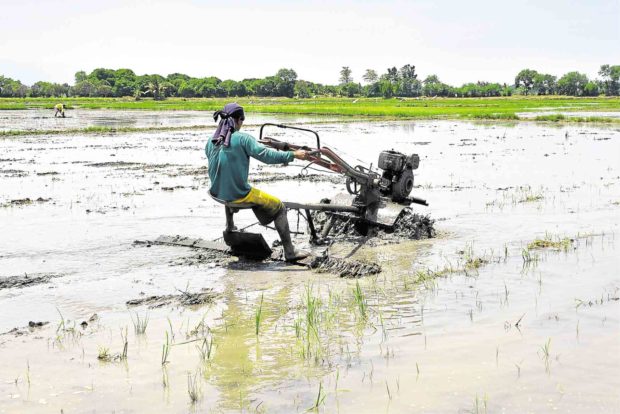Floods’ impact on rice supply seen negligible

LAID TO WASTE At the start of the month, Pangasinan farmers prepare land for planting only to see this and other farms go under water weeks later because of flooding.—WILLIE LOMIBAO
LINGAYEN, PANGASINAN—One look at all the water resting on thousands of hectares of rice farms in several Luzon provinces could lead to the conclusion that supply would soon take a hit.
Not so, according to Agriculture Secretary Emmanuel Piñol on Thursday.
Although a large area of rice-producing land had been destroyed, Piñol said this actually would not have any effect on the country’s rice supply.
“The floods may look daunting actually,” he said during a visit here to check on farms hit by flooding from monsoon rains and several storms in the past few days.
But he said that “computations” made by “our experts” showed that the flooding would have minimal impact on rice production nationwide, or “less than 1 percent.”
Article continues after this advertisement“We’re expecting the farmers to recover,” he added.
Article continues after this advertisementEstimated losses
The floods started last weekend, destroying crops and fisheries worth P1.2 billion in Central Luzon and P1 billion in Pangasinan.
Piñol said rains and floods struck when rice crops were in their vegetative stage.
“This is why it is very important for us to immediately deliver the seeds so that the affected farmers could immediately plant,” he said at a dialogue here with farmers and local government officials.
Piñol committed to opening a P50-million credit line, which farmers can avail themselves of at zero interest and with no collateral.
He also gave 32,000 bags of hybrid palay seeds worth P81 million to farmers.
Different situations
He said many farms in Pangasinan were still flooded, in contrast to Bataan where floodwaters receded quickly.
There were also parts of Camiling town in Tarlac and parts of Pampanga and Bulacan that were still flooded, he said.
Piñol said floodwaters were mixed with mud, an indication of soil erosion which buried parts of rice fields.
“That could only be an indication that we really need to replan our agriculture. We really have to revisit the way we do agriculture in undulating and upland areas,” he said.
He said steep farms should not grow cash crops.
“Only trees, fruit trees and crops that can hold soil should be planted,” he said.
More deaths
Three more deaths were reported due to the massive flooding in Pangasinan.
On Wednesday, two children drowned in separate cases in Malasiqui town.
Jerico Arzadon, 7, was bathing in the rain in a rice field at the village of Manggan-Dampay when he fell into a pond and drowned.
Marian Salazar, 10, was also bathing when she slipped and fell into a river in the village of Bobon.
In Dagupan City, Barbara Carrera died in a hospital, four days after she fell into a coma after she touched a live wire dangling from an electric post while wading in a flooded street on Sunday.—GABRIEL CARDINOZA